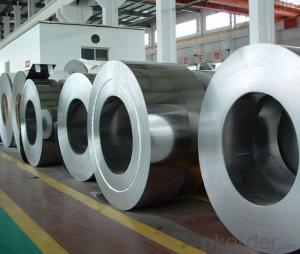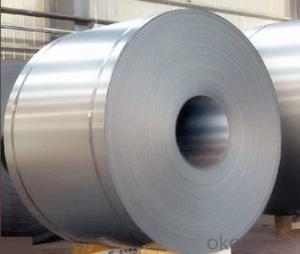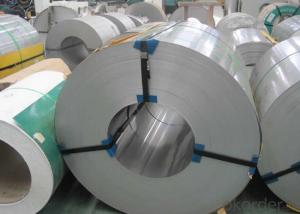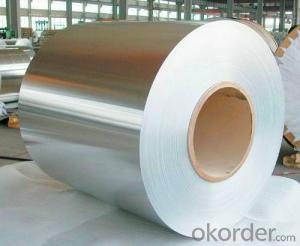Hot / Cold Rolled Stainless Steel Coil 201
- Loading Port:
- Lianyungang
- Payment Terms:
- TT OR LC
- Min Order Qty:
- 100 m.t.
- Supply Capability:
- 5000 m.t./month
OKorder Service Pledge
OKorder Financial Service
You Might Also Like
Hot Rolled Stainless Steel Coil 201 Narrow Strip No.1 Finish
Hot Rolled Stainless Steel 201 half copper Chemical Composition(%) | |||||||
C | Si | Mn | P | S | Ni | Cr | Cu |
0.1 | 0.5 | 10 | 0.04 | 0.01 | 1.20/1.30 | 13.00/14.00 | 0.8/1.0 |
Grade: | 200 Series | Standard: | JIS,AISI,ASTM,GB,DIN | Thickness: | 2.5/3.0/4.0mm |
Width: | 485/510/550/610/1010/1240mm | Place of Origin: | Shanghai China (Mainland) | Brand Name: | CNBM |
Model Number: | 201 | Technique: | Hot Rolled | Application: | Industrial tubes/kitchen/bath |
Certification: | ISO | THK: | 2.5/3.0/4.0mm | Face: | No.1 |
Usage: | tubes/kitchen/bath | Origin: | CHINA | ||
Packaging Detail: For customer's requirement
Delivery Detail: 10-30days
201 Hot Rolled Stainless Steel Coil Specifications
THK:2.3/2.5/3.0/4.0mm
Width:485/510/550/610/1010/1240mm
Face:No.1
201 Hot rolled stainless steel Coil Application
Stainless steel is a production which not easy rust,acid resistance and corrosion resistance,so it is widely
used in light industry,heavy industry,daily necessities and the decoration industry.
201 hot rolled stainless steel coil, use to produce cold rolled stainless steel coil and stainless steel tube, pipe.
201 Hot Stainless Steel Coil Chemical Composition(WT%)
(C):≤0.15, (Si):≤0.75, (Mn):5.5~7.50, (Cr):16.0~18.0, (N):≤0.25, (Ni):3.50~5.50, (P):≤0.060, (S):≤0.030
201 Hot Rolled Stainless Steel Coil
Strength Of Extension:100,000 To 180,000 Psi;
Yield Strength:50,000 To 150,000 Psi
Elongation :55 To 60%;
Modulus Of Elasticity:29,000,000 Psi;
Density :.280lbs/Cubic Inch(7.93g/Cm3)
- Q:Can 111 stainless steel strips be coated with anti-fingerprint coatings?
- Indeed, it is possible to apply anti-fingerprint coatings on a total of 111 stainless steel strips. These coatings are specifically crafted to minimize the appearance of fingerprints and smudges on stainless steel surfaces, resulting in simplified cleaning and maintenance procedures. It is feasible to utilize this coating on different stainless steel grades, including 111 stainless steel. However, it is crucial to seek guidance from a reputable coating supplier or manufacturer to confirm the compatibility of the chosen anti-fingerprint coating with 111 stainless steel, ensuring it fulfills the desired performance criteria.
- Q:How are stainless steel strips made?
- The production of stainless steel strips involves a technique called cold rolling, wherein a stainless steel coil is passed through a set of rollers at room temperature. This action progressively reduces the thickness and increases the length of the coil. To begin, the stainless steel coil is unwound and cleaned to eliminate any dirt or impurities. Subsequently, it is subjected to a series of rolling mills where the thickness is gradually decreased. These mills consist of two or more rollers that apply pressure to the metal, causing it to elongate and become thinner. This process is repeated until the desired thickness is achieved. As the stainless steel strip becomes thinner, it becomes more rigid and challenging to handle. To counteract this issue, annealing is conducted at specific intervals during the rolling process. Annealing involves heating the strip to high temperatures and slowly allowing it to cool. This procedure helps alleviate internal stresses and enhance the strip's ductility. Following the cold rolling and annealing stages, the stainless steel strip may undergo additional treatments such as descaling, pickling, and passivating. Descaling eliminates any scales or oxides that may have formed on the strip's surface during rolling. Pickling involves treating the strip with an acid solution to eliminate any remaining impurities. Passivation is the final step, in which a thin, protective oxide layer is formed on the surface of the stainless steel, enhancing its corrosion resistance. Once all of these processes are completed, the stainless steel strip is cut to the desired length and packaged for shipment or further processing. Its exceptional strength, durability, and resistance to corrosion make it suitable for a wide range of applications, including automotive components, kitchen appliances, construction materials, and electronic devices.
- Q:How do stainless steel strips perform in high-temperature environments?
- High-temperature environments are where stainless steel strips truly shine, thanks to their exceptional performance. The key to their success lies in their unique composition, which boasts a high percentage of chromium. This chromic element forms a protective layer of chromium oxide on the surface of the stainless steel, effectively safeguarding it from corrosion and oxidation, even when exposed to elevated temperatures. When faced with high-temperature conditions, stainless steel strips exhibit remarkable heat resistance while maintaining their mechanical properties. They are capable of enduring thermal cycling without experiencing significant deformation, thereby ensuring their dimensional stability and structural integrity. This remarkable characteristic renders them suitable for a broad range of applications that necessitate continuous exposure to high temperatures, such as heat exchangers, exhaust systems, and industrial furnaces. Moreover, stainless steel strips retain their strength and hardness when subjected to elevated temperatures, guaranteeing dependable performance in demanding circumstances. They possess excellent resistance to creep and stress rupture, allowing them to withstand prolonged exposure to high temperatures without succumbing to deformation or failure. These attributes render them highly reliable in critical applications where safety and durability are of utmost importance. In addition, stainless steel strips possess low thermal expansion coefficients, meaning they expand minimally even when subjected to extreme temperatures. This property plays a crucial role in minimizing thermal stresses and preventing warping or distortion of the material, thereby ensuring its dimensional stability over time. In conclusion, stainless steel strips are an outstanding choice for high-temperature environments due to their corrosion resistance, heat resistance, mechanical strength, and dimensional stability. Their exceptional performance in these conditions has made them the preferred material for various industries, where they consistently rise to the challenges posed by extreme temperatures.
- Q:Can stainless steel strips be formed into coils or rolls?
- Yes, stainless steel strips can be formed into coils or rolls. The flexibility and ductility of stainless steel allow it to be easily shaped and rolled into various coil or roll forms for different applications.
- Q:What are stainless steel strips used for?
- Due to their unique properties and versatility, stainless steel strips have a wide range of applications. Various industries, including automotive, construction, aerospace, and manufacturing, commonly utilize them. In the production of kitchen appliances and utensils, stainless steel strips are essential. Their corrosion-resistant nature prevents rust and staining, ensuring a longer lifespan for these products. Additionally, they are used to fabricate sinks, countertops, and backsplashes, which provide a durable and hygienic surface that is easy to clean. Within the automotive industry, stainless steel strips are employed in the manufacturing of exhaust systems, mufflers, and trim components. This is due to their high-temperature resistance and corrosion resistance, which guarantee longevity and performance even in harsh conditions. Construction and architecture also benefit from stainless steel strips. These strips can be found in structural components such as beams, columns, and reinforcement bars. In environments where corrosion or weathering is a concern, the durability and strength of stainless steel make it an ideal choice. The manufacturing industry relies on stainless steel strips for the fabrication of machinery and equipment. Conveyor belts, springs, and fasteners are all made using these strips. The strength, toughness, and resistance to wear and tear of stainless steel make it a reliable choice in these applications. In conclusion, stainless steel strips are essential materials in a wide range of applications. Their corrosion resistance, durability, strength, and aesthetic appeal make them versatile and indispensable in various industries.
- Q:How do stainless steel strips perform in seawater environments?
- Stainless steel strips are highly resistant to corrosion in seawater environments due to their composition, which includes a high percentage of chromium. This chromium forms a protective layer on the surface of the steel, preventing the corrosive effects of saltwater. Therefore, stainless steel strips demonstrate excellent performance and durability in seawater environments.
- Q:Can stainless steel strips be used in chemical processing?
- Indeed, chemical processing can incorporate stainless steel strips. Renowned for its impressive resistance to corrosion, stainless steel proves to be an ideal material for a multitude of applications within the chemical industry. With its ability to withstand a wide range of aggressive chemicals, acids, and bases, as well as its capacity to endure high temperatures and pressures, stainless steel emerges as a commonly utilized component in chemical processing machinery, including reactors, heat exchangers, storage tanks, and piping systems. Offering durability, dependability, and an extensive lifespan, stainless steel strips are the favored choice for handling corrosive chemicals and upholding product purity during chemical processing operations.
- Q:Can stainless steel strips be formed into different shapes?
- Yes, stainless steel strips can be formed into different shapes through various metalworking processes such as bending, rolling, and stamping.
- Q:Can stainless steel strips be used in architectural facades?
- Architectural facades can indeed utilize stainless steel strips. This material, known for its versatility and durability, offers numerous advantages in architectural applications. Its resistance to corrosion, impressive strength, and pleasing aesthetic make it a perfect selection for exterior facades. To enhance the appearance and functionality of architectural facades, stainless steel strips may be employed in various ways. They can serve as cladding material, enveloping the building's exterior to achieve a sleek and contemporary look. Furthermore, these strips can be utilized as decorative elements, introducing texture and visual interest to the facade. Apart from its aesthetic qualities, stainless steel boasts exceptional durability and longevity. It resists corrosion, rust, and staining, making it highly suitable for outdoor usage. Moreover, stainless steel demands minimal maintenance, necessitating only infrequent cleaning and upkeep. In addition, stainless steel strips can be tailored to fit specific design requirements for architectural facades. Various finishes, colors, and patterns can be applied, allowing for customization. They can be polished to a high shine, brushed for a matte appearance, or even coated with different colors and patterns, resulting in a one-of-a-kind aesthetic. Ultimately, stainless steel strips are a versatile and dependable choice for architectural facades. Their combination of durability, aesthetic appeal, and customization options makes them a favored material for both functional and decorative purposes in architectural design.
- Q:How is stainless steel strip manufactured?
- Stainless steel strip is manufactured through a series of processes that involve shaping and cutting stainless steel sheets. The production starts with the selection of high-quality stainless steel alloy, typically containing chromium and nickel, which provides corrosion resistance and durability. The manufacturing process begins by feeding the stainless steel sheets into a rolling mill, where they are passed through multiple sets of rollers. These rollers gradually reduce the thickness of the sheets, resulting in a thinner and longer strip. The rolling process is repeated several times to achieve the desired thickness and dimensions. After the rolling process, the stainless steel strip is annealed to remove any internal stresses and improve its ductility. Annealing involves heating the strip to a specific temperature and then slowly cooling it down. This process helps to enhance the mechanical properties of the strip and makes it easier to work with in subsequent manufacturing steps. Once annealed, the strip may undergo various additional processes, depending on the desired end-use. These may include surface treatments such as pickling or passivation to remove any impurities or oxides and improve the surface finish. The strip may also be coated or polished to enhance its appearance or protect it from corrosion. Finally, the strip is cut into the desired lengths using shearing or slitting machines. Shearing involves cutting the strip in a straight line to produce individual pieces of the desired width. Slitting, on the other hand, involves cutting the strip into narrower widths, commonly used for applications such as flexible metal hoses or electrical components. Overall, stainless steel strip manufacturing involves precise control of rolling, annealing, and cutting processes to ensure the production of high-quality strips that meet the required specifications and standards. The resulting stainless steel strips are widely used in various industries, including automotive, aerospace, construction, and manufacturing, due to their excellent corrosion resistance, strength, and versatility.
1. Manufacturer Overview |
|
|---|---|
| Location | |
| Year Established | |
| Annual Output Value | |
| Main Markets | |
| Company Certifications | |
2. Manufacturer Certificates |
|
|---|---|
| a) Certification Name | |
| Range | |
| Reference | |
| Validity Period | |
3. Manufacturer Capability |
|
|---|---|
| a)Trade Capacity | |
| Nearest Port | |
| Export Percentage | |
| No.of Employees in Trade Department | |
| Language Spoken: | |
| b)Factory Information | |
| Factory Size: | |
| No. of Production Lines | |
| Contract Manufacturing | |
| Product Price Range | |
Send your message to us
Hot / Cold Rolled Stainless Steel Coil 201
- Loading Port:
- Lianyungang
- Payment Terms:
- TT OR LC
- Min Order Qty:
- 100 m.t.
- Supply Capability:
- 5000 m.t./month
OKorder Service Pledge
OKorder Financial Service
Similar products
New products
Hot products
Related keywords





























